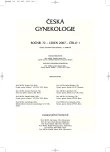Transvaginal Hydrolaparoscopy and Ultrasonographically Guided Transvaginal Hydrolaparoscopy – Two Outpatient Methods of Pelvis Examination
Authors:
A. Sobek jr.; J. Vodička; A. Sobek
Authors‘ workplace:
Fertimed, centrum pro léčbu neplodnosti
vedoucí doc. MUDr. A. Sobek, CSc.
Published in:
Ceska Gynekol 2007; 72(1): 11-15
Category:
Original Article
Overview
Objective:
The aim of this study is to describe transvaginal hydrolaparoscopy (THL) and ultrasonographically guided transvaginal hydrolaparoscopy (UTHL) used in the examination of the female pelvis in patients treated for infertility. Emphasis was placed on the safety of both procedures.
Setting:
Fertimed, Infertility centre, Olomouc.
Methods:
Transvaginal hydrolaparoscopy is an outpatient method for the examination of the female pelvis. Optics are inserted via the posterior vaginal wall and the tuboovarian complex is examined in saline solution. In ultrasonographically guided transvaginal hydrolaparoscopy, ultrasound is used during whole examination. The control of position of ultrasound instruments during the whole procedure increases the safety of the procedure and decreases difficulty of the method.
Results:
9 patients were examined with transvaginal hydrolaparoscopy. In 2 patients, (22%), insertion of the needle was complicated by bowel injury. Based on the experience with transvaginal hydrolaparoscopy we developed a modified version: Ultrasonographically guided transavaginal hydrolaparoscopy. With this method we examined 460 patients. Access to the abdominal cavity was successful in 100 %. In 1.7 %, the examination was not done due to a lack of fluid in Douglas space. Bowel injury was not detected.
Visualisation of both adnexa was similar in both methods (94.5%). Small asymptomatic periovarial adhesions were found in 16 %. In 5.2 %, we found grade I endometriosis. Laparoscopy was recommended in 15.7 % due to tubarian obstruction, severe adhesions, or poor adnexal visibility. Surgical intervention was necessary in 86.2 % of those patients.
Conclusions:
Transvaginal hydrolaparoscopy and ultrasonographically guided transvaginal hydrolaparoscopy are new methods for examination of tuboovarian complex. Ultrasonographically guided transvaginal hydrolaparoscopy ensures safer and easier access to the abdominal cavity with low complication rate.
Key words:
THL, UTHL, sterility, tubarian obstruction, hydrolaparoscopy.
Labels
Paediatric gynaecology Gynaecology and obstetrics Reproduction medicineArticle was published in
Czech Gynaecology

2007 Issue 1
Most read in this issue
- Choroid Plexus Cysts and Risk of Trisomy 18. Modifications Regarding Maternal Age and Markers
- Efektivita měření nosní kosti jako UZ markeru pro Downův syndrom v 11.-13+6. týdnu gravidity
- Ovarian Hypertimulation Syndrome: a Review
- Laparoscopic Myomectomy: Indications and Limits
